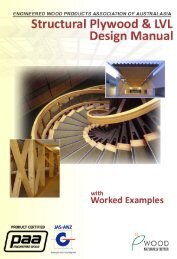Facts About Particleboard and MDF - Engineered Wood Products ...
Facts About Particleboard and MDF - Engineered Wood Products ...
Facts About Particleboard and MDF - Engineered Wood Products ...
You also want an ePaper? Increase the reach of your titles
YUMPU automatically turns print PDFs into web optimized ePapers that Google loves.
efore final coats, <strong>and</strong> the use of a semi gloss finish will minimise the texturing mentioned above <strong>and</strong><br />
produce a quite satisfactory result for most applications.<br />
Vinyl Film<br />
These can be wood grain prints with matching embossing, or plain colours, with a smooth or textured<br />
surface. Higher quality wood grain pattern are usually surface printed with a clear protective PVA overlay or<br />
highly scratch resistant lacquer finish.<br />
PVC film can be applied on a small scale using, for instance, cold setting ethyl vinyl acetate (EVA) emulsion<br />
adhesives in simple nip roll presses. However for high quality, high volume production, continuous laminating<br />
lines are required. EVA emulsions, two-part solvent-based polyurethane or epoxy systems are used. The<br />
adhesive is applied as a thin film to either the board surface or reverse side of the vinyl <strong>and</strong> where applicable,<br />
the excess solvent is flashed off <strong>and</strong> the vinyl nip-rolled onto the board. Vinyl coated board is available from<br />
wood panel manufacturers as well as independent processors laminating for the industry. The product is<br />
generally used for furniture manufacture, e.g. wall units, TV <strong>and</strong> Hi Fi cabinet speaker boxes <strong>and</strong> computer<br />
desks. The flexible nature of the PVC film has resulted in the development of the V grooving technique where<br />
the substrate is machined away leaving a 90 0 groove connected only by the PVC. This can then be folded to a<br />
right angle or to more complex profiles - many grooves of varying sizes are machined <strong>and</strong> multiple folding<br />
produces a shaped edge e.g. the front edge of a TV cabinet.<br />
As with other laminated wood panel products, it is recommended that for large, freest<strong>and</strong>ing panels, a<br />
balancing film is applied to the reverse side.<br />
Matching edge b<strong>and</strong>ing can be obtained from vinyl manufacturers for edge finishing. High volume production<br />
is usually carried out on a proprietary edge b<strong>and</strong>ing machine using hot melt adhesive. Small operations can<br />
be carried out by h<strong>and</strong> using contact adhesive.<br />
PVC film is not generally recommended for horizontal work surfaces.<br />
Veneer<br />
Natural wood veneer is generally regarded as the premium decorative finish for wood panels because of the<br />
individuality offered in choice of grain definition <strong>and</strong> species. Veneers are readily applied to <strong>Particleboard</strong> <strong>and</strong><br />
<strong>MDF</strong> provided the substrate is of good quality, the board is uniform in thickness <strong>and</strong> the surface is dense <strong>and</strong><br />
smooth with well bonded surface flakes. Urea formaldehyde <strong>and</strong> crosslinking P.V.A. resins are normally used.<br />
In order to obtain stability of the product a balancing veneer must always be applied to the reverse side.<br />
Veneered <strong>Particleboard</strong> <strong>and</strong> <strong>MDF</strong> is available in good-one-side or good-two-sides configuration in both sliced<br />
<strong>and</strong> rotary cut veneers, <strong>and</strong> is usually supplied fine s<strong>and</strong>ed by the manufacturer. Veneers can be finished with<br />
clear lacquer, oil, stain or paint depending on the wood species <strong>and</strong> the end product requirement. Exposed<br />
edges of veneered <strong>Particleboard</strong> panels are generally protected by matching solid timber edging, matching<br />
veneer applied by an edge b<strong>and</strong>er using hot melt adhesive or by the use of pre-glued, "iron on" veneer.<br />
Veneered <strong>MDF</strong> panels may have similar edge treatment but <strong>MDF</strong> edges can also be moulded <strong>and</strong> machined<br />
due to the better edge machining properties of <strong>MDF</strong>.<br />
33

















